History
For the past years people had been witnessing the appearance of facial recognition technology mostly in science fiction movies and books; however, for the past decade or so facial recognition technology is being used in our everyday lives from law enforcement agencies to supermarket payments to airport security.
Journalist Jennifer Tucker in her article How Facial Recognition Technology Came To Be (2014), challenges the idea that the very first tool that was used for recognizing a person, was surprisingly invented in 1839 when just a simple camera was considered to be a means for tracking down and catching criminals. Prison photography was even a thing back when in Victorian England cameras were used to take photos of all the inmates so prison guards could keep track of them and because it was the only way they could have their actual faces on paper in case anyone escaped.However, even there we see problems in the technology used, as the quality of the photos was not always great and people would be mistaken or falsely accused of crimes they had not committed.

Tucker continues her claims by suggesting that during the 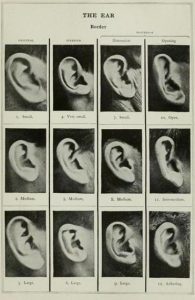 end of the 19th century, a French police official from Paris, Alphose Bertillon, developed a system where he classified photographs of criminals’ body parts and measurements as a documented database that law enforcement could search through.
end of the 19th century, a French police official from Paris, Alphose Bertillon, developed a system where he classified photographs of criminals’ body parts and measurements as a documented database that law enforcement could search through.
From “Signaletic Instructions”, 1896.
Then during the early 1900s there was an increase in the category of lawsuits aimed against photographers who usually would have published people’s portraits without their permission. And in 1919 the FBI made its first “identification order” for a man who was wanted for escaping his army duty.
The first man to be put on an FBI “Wanted” poster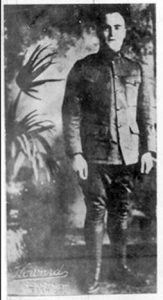
The FBI unlike Jennifer Tucker assumes the start of the history of facial recognition technology with the appearance of the first automated facial recognition technology, when Woodrow Wilson Bledsoe came up with “the first semi-automated system for face recognition” (FBI, 2001) in the 1960’s. A system that would manually categorize photos of people’s faces with the help of a device called a RAND tablet, which was basically a tool that was used to manually document the position of various main points on the face like the eyes, the nose, and the mouth. Once the measurements had been inserted in the database, every time a new photo would be put it the system, it would return the photo with the closest measurements. In the 1970s the use of 21 specific subjective markers was added in the expansion of face recognition, such as one’s hair color or the thickness of their lips (whereas now Face++ software uses 83 different key points on one’s face). However, these techniques all had problems like any other technological gadget or advancement and all of these aforementioned methods had the flaw that any type of data or measurement that was added into the system had to be put there manually.
To overcome this issue, new ideas were developed during the 1980s and 1990s that used mathematical algorithms and more specifically a “linear algebra-based system called Eigenfaces” (Tucker, 2014). 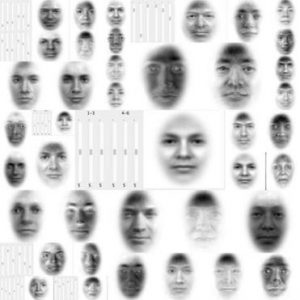
Examples of Eigenfaces. Wikipedia Commons, 2014.
This system can design a human face by maneuvering and altering the variable used to create the face. Between those years and the early 2000s more and newer programs were created that contained better quality images and increasingly growing photo databases. According to Tucker, after the 9/11 attacks, there was a big expansion on the work of biometrics and identifying the enemy. Portable systems that use facial recognition technology were developed to track and document members of the population of Afghanistan and Iraq. (Like the portable eye-gadget facial recognition technology seen in Black Mirror). Facial recognition technology was also used in 2011 to confirm Osama Bin Laden’s death. That same technology has now been even more developed and is used in our everyday lives when it comes to local law enforcement and police or even for big public events for security reasons.
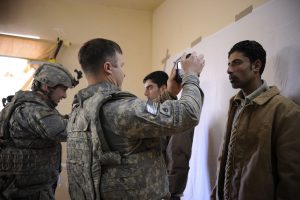
Photo from the US Military, 2010. US soldiers are putting Iraqi citizens’ data into a biometrics system. 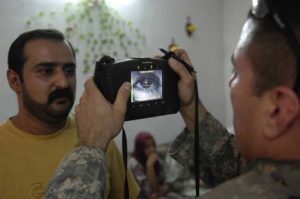 Photo from the US Military, 2010. Depicting a handheld iris scanner.
Photo from the US Military, 2010. Depicting a handheld iris scanner.
Meanwhile, facial recognition technology started being implemented in the world of social media with its first appearance in 2010 on Facebook, where the system helped you recognize people’s faces that were in photos in order to make it easier for the user to tag his or her friend(s) in the photos. According to company FaceFirst, each day “more than 350 million photos are uploaded and tagged using face recognition” on Facebook. Now we see it on Snapchat, on the new iPhone and of course we even still see it in movies and series.